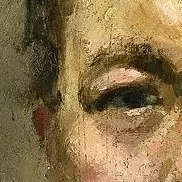Left panel:

(From wiki) Nihonga are typically executed on washi (Japanese paper) or eginu (silk), using brushes. The paintings can be either monochrome or polychrome. If monochrome, typically sumi (Chinese ink) made from soot mixed with a glue from fishbone or animal hide is used. If polychrome, the pigments are derived from natural ingredients: minerals, shells, corals, and even semi-precious stones like malachite, azurite and cinnabar. The raw materials are powdered into 16 gradations from fine to sandy grain textures. A hide glue solution, called nikawa, is used as a binder for these powdered pigments. In both cases, water is used; hence nihonga is actually a water-based medium. Gofun (powdered calcium carbonate that is made from cured oyster, clam or scallop shells) is an important material used in nihonga. Different kinds of gofun are utilized as a ground, for under-painting, and as a fine white top color.
Thanks for introducing me to this. I hadn’t seen it before. FYI, there’s a higher resolution version on the Japanese Wikipedia:


